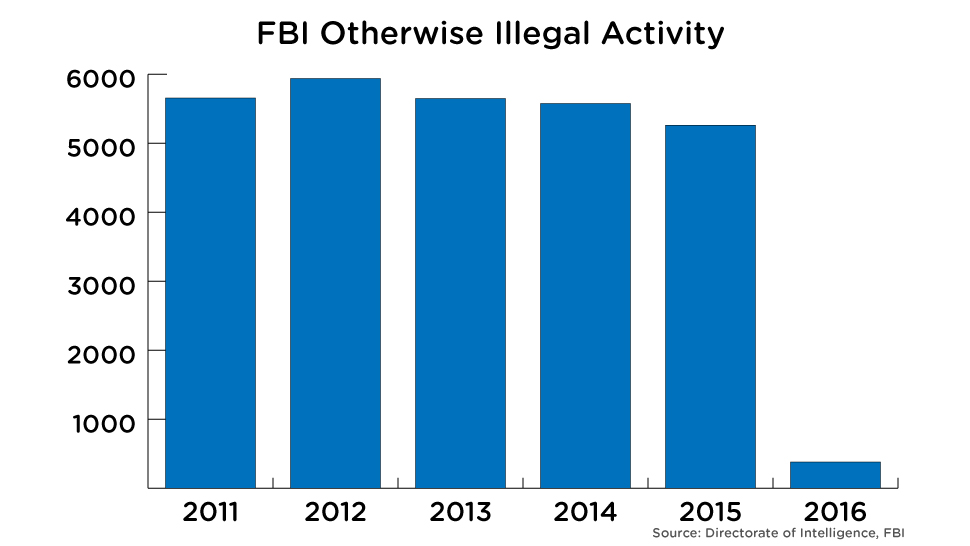This year, the FBI appears to for the first time have overlooked a reporting obligation established by the US Attorney General’s office, and in doing so, the bureau appears to have greatly low-balled the total number of times it authorised confidential informants to engage in criminal activity last year.
Photo: AP
As a consequence, the bureau did something else that’s new: It revealed the number of times it gave informants permission to engage in serious criminal activity. And lacking an official explanation so far, our running theory is that a clerical error could be to blame.
Each year, the FBI Directorate of Intelligence compiles a report on what the US Justice Department calls “otherwise illegal activity” (OIA) — activity FBI informants are involved in that would otherwise be illegal, had the FBI not given them permission to do it.
There are some crimes the FBI is forbidden from authorising. Those include acts of violence and obstruction of justice (that is, witness tampering, entrapment, fabrication of evidence). Its informants are also prohibited from “initiating or instigating” a plan to commit a crime. Otherwise, authorised informants may engage in criminal activity to maintain cover and provide the bureau with intelligence on other, presumably worse criminals, so long as certain protocols are observed.
These protocols are explained in a document known as The Attorney General’s Guidelines Regarding the Use of Confidential Informants. Since at least 2006, this document has included a number of record-keeping requirements. One is that the FBI must submit an annual report to the Justice Department’s Criminal Division and National Security Division describing “the total number of times each FBI Field Office authorised a Confidential Human Source to engage in Otherwise Illegal Activity (OIA), and the overall nationwide totals”.
These OIA reports are traditionally drafted between January and March each year. The yearly average of otherwise illegal activities reported between 2011 and 2015 is around 5600. In 2012, the number peaked at 5939. The lowest number was in 2015, when the FBI only reported only 5261 authorisations for criminal activity, according to new records obtained by Gizmodo under the Freedom of Information Act.
The authorisations for OIA must be renewed every three months, so technically it’s possible each individual authorisation covers a multitude of criminal acts. In other words, the figures don’t actually represent crimes, but 90-day windows in which informants are allowed to break the law.
The 2016 report, which was compiled by the assistant director of the FBI Intelligence Directorate, appears wildly inaccurate at first blush. The number of authorisations for criminal activity reported to the Justice Department this March was only 381.
Here’s what that looks like compared to the previous five years:

What?
Either the FBI has dramatically curtailed how often it allows informants to break the law, or something isn’t right here. Here’s a closer look at the actual numbers, side by side:
- 2011: 5658 (USA Today)
- 2012: 5939 (Huffington Post)
- 2013: 5649 (The Daily Dot)
- 2014: 5577 (The Daily Dot)
- 2015: 5261 (Gizmodo)
- 2016: 381 (Gizmodo)
If you picked “something isn’t right here,” then you are correct. It turns out the FBI actually failed to report any entire tier’s worth of criminal activity, thereby significantly reducing the overall number of authorised crimes it reported. That’s about a 93 per cent drop in the OIA total.
Authorised crimes by informants are divided into what the FBI calls “tiers”. Tier 1 activities are more serious types of crimes, importing huge amounts of heroin for instance; whereas Tier 2 includes basically everything else, down to shoplifting.
Here’s an incomplete list of what’s considered Tier 1 activity:
- The commission, or the significant risk of the commission, of any act of violence by a person or persons other than the Confidential Human Source;
- Corrupt conduct, or the significant risk of corrupt conduct, by an elected public official or a public official in a high-level decision-making or sensitive position in federal, state or local government;
- Manufacturing, importing, exporting, possession or trafficking of controlled substances in a quantity equal to or exceeding those quantities specified in United States Sentencing Guidelines § 2D1.1(c)(1) (90kg of heroin, 450kg of cocaine, 90,000kg of marijuana, and so on);
- Financial loss, or the significant risk of financial loss, in an amount equal to or exceeding those amounts specified in United States Sentencing Guidelines § 2B1.1(b)(1)(I) ($US1.5 million [$1.9 million].)
Conversely, Tier 2 activity is simply defined as “any other activity that would constitute a misdemeanour or felony under federal, state, or local law if engaged in by a person acting without authorization”.
Most of the time, we can’t tell the difference between the two. For reporting purposes, Tier 1 and 2 criminal activity is usually bundled into a single total. And that means that in 2015 the FBI may have authorised its informants to commit 5261 misdemeanours for all we know.
But this year, something different happened. Tier 2 wasn’t included. And now we know that in 2016, at least 381 times, the FBI authorised its informants to engage in some really serious criminal activity. Whether that was commissioning an act of violence by another person or manufacturing a truckload of cocaine, we can’t be sure.
So, how did this happen exactly? Was it a clerical error or did the FBI do this on purpose? Did the Attorney General’s office issue new guidelines? We’re not entirely sure. The US Justice Department declined to comment, even though it sets the rules and, by all appearances, its National Security Division was robbed of an important statistic. The FBI told Gizmodo yesterday that it was working on an answer.
